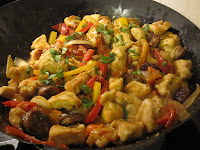 |
I have had this dish in many forms but my favorite was at a little pizzeria in Rye, NY. The owner called his dish Chicken with Vinegar Peppers, and he did not even have it on the menu, it was just one of his specialities. All the other variations I have tasted in other restaurants were okay, but most were dry, or lacked taste, but when I sampled this humble dish in that little restaurant, I knew I had to try it someday and make it my own.
I did a bit of research, and like many Italian-American dishes, this one is of uncertain origin. The word scarpariello means shoemaker, so this dish is really called Shoemaker's Chicken. This brings to mind another recipe in an earlier blog, Chicken Cacciatore, or Hunter's Chicken.
 |
| Gathering the Ingredients |
I have to give credit to my friend and colleague and fellow foodie Lauren DeGasperis, who responded to my request for ideas for my blog. Chicken Scarp (yes, it has a nickname), what a great idea, I thought! Who makes that? No one at home, to my knowledge...thanks Lauren!
I had never made this dish before, and consulted many sources, including a recipe from Rao's restaurant, Lidia and some others. They were all pretty similar, with some variations. It was chicken, sausage, fresh and marinated peppers, onion and garlic with aromatic herbs, in a tangy, spicy sauce flavored with the vinegar water from the jar of marinated peppers, white wine and lemon juice. One thing they all agreed upon: it is all in the sauce, which should be pungent and flavorful. Most of the recipes called for chicken broth, but I substituted Better Than Bouillion, chicken flavor, which is a great find: a teaspoon adds tons of flavor without adding to the reduction time.
A note about heat: This dish can be made hot or sweet. I used sweet sausages, but hot cherry peppers, the vinegar water from the hot peppers, and red pepper flakes. It was spicy hot but not insanely hot. If you are a hot hot spicy food aficionado, you might want to try hot sausages. If you do not care for hot food, use the sweet sausages, sweet cherry peppers, and their juice. However, a hint of heat adds a subtlety of flavor, so I would keep the red pepper flakes.
I opted to use boneless chicken breast, but boneless, skinless chicken thighs could be substituted. Most of the recipes called for chicken on the bone, however I think boneless, if cooked correctly, is easier and prettier to serve. To avoid the inevitable dryness of chicken breast, I opted to first dredge the cubed pieces in flour, and quickly saute them olive oil in a very hot cast iron pan. Browning the pieces quickly, they did not overcook and remained succulent, moist and delicious. The flour gave body to the sauce, which adhered to both the meat and the vegetables. If thigh meat is used, it would even be more moist due to the higher fat content.
 |
| Much neater this way! |
Here is the recipe for Chicken Scarpariello with Sausages. If desired, it can be halved for smaller families, smaller appetites, and fewer leftovers!
CHICKEN SCARPARIELLO with Sausages
"Shoemaker's Chicken"
Ingredients:
1/2 cup extra virgin olive oil (divided)
6 boneless, skinless chicken breast halves or 12 boneless, skinless chicken thighs
Flour for dredging, seasoned with salt and pepper, 2 teaspoons or equivalent oregano (see below)
6 sweet or hot boiled Italian sausages, fennel or plain, large sized, cut into 1/2 inch rounds
1 red and 1 yellow pepper (or color of your choice!) cut into strips
I large spanish onion or two regular yellow onions
4 cloves garlic
1/2 16 ounce jar hot or sweet cherry peppers in vinegar, sliced thin or cut in half
1 16 ounce jar sweet red roasted peppers in vinegar, cut into strips
1 cup vinegar water from cherry peppers
1 cup white wine
red pepper flakes to taste
1 teaspoon "Better Than Boullion" boullion concentrate (chicken flavor)
2 sprigs fresh rosemary or 1/2 teaspoon dried
2 sprigs dried oregano (use Sicilian Oregeno, available at specialty markets), the highest quality you can find
juice and zest from one lemon
Fresh parsley
 |
| Deliciously but quickly browned |
 |
| These also cook very fast! |
3. Boil the sausages, until they are white and firm, about 7 to 10 minutes. Let cool, slice into rounds. Fry until brown, do not overbrown, it also happens quickly. Keep the flame low to render the fat out of the sausages. Mix the chicken and sausages together, and set aside.
 |
| Peppers, onions, garlic and spices! |
 |
| Yes, I used a wok for this Italian American dish! |
My family absolutely loved this dish. It may be served with rice or pasta, or just some hot Italian bread and a green salad with viniagrette. Enjoy!
Buon appetito!




















































